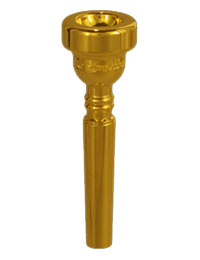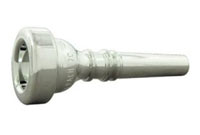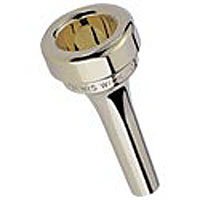The Quest for the Perfect Mouthpiece - Have you found yours yet?
25-Jan-2007Steve Herbert, Brass Department Manager at John Packers Ltd gives a brief oversight to the somewhat impossible quest of finding the perfect mouthpiece.
Sorry to announce to you all that the ‘perfect' mouthpiece does not exist, if such a mouthpiece did then here at John Packers we would only have to stock that single mouthpiece!
Visit our shop in Taunton, Somerset and you will see a large selection of mouthpieces to choose from. Therefore a different sized mouthpiece can assist the player to achieve what he or she is looking for, but there is no substitute for the correct type of practice/ embouchure / use of diaphragm etc which would be an entire article on its own.
Almost all new instruments come with a mouthpiece and a beginner would be advised to use the mouthpiece it comes with for awhile, unless they are already using and are happy with their existing mouthpiece. The student trombones usually come with either a 6.5AL or a 12C which are considered to be suitable for most new starters, while the professional Conn 88H comes with a 5G which many players continue to use as it is considered to be a good all round mouthpiece. Student trumpets often come with a 7C or 5C mouthpiece which are deemed suitable by most instrument makers.
To answer questions about when to change mouthpiece and what to change to is not an easy one to answer as you need to consider many factors as the dimensions and shape of the mouthpiece has direct impact on its feel, playability and sound.
Cup Diameter (Internal Rim) In general, a small cup diameter makes it easier to play high notes and can increase endurance, but volume is limited. A larger cup diameter, on the other hand provides plenty of volume and easy low tones but endurance may be sacrificed.
In general, a small cup diameter makes it easier to play high notes and can increase endurance, but volume is limited. A larger cup diameter, on the other hand provides plenty of volume and easy low tones but endurance may be sacrificed.
Rim Contour
Since this is the part of the mouthpiece that comes into contact with the lips it is a crucial parameter for playing comfort. Rim contour also has a large effect on attack and clarity.
Rim Thickness
A thick rim provides greater lip contact area for easier high notes and extended endurance, but lip movement is limited thus reducing tonal flexibility. A thin rim offers plenty of control over a wide range but can quickly cause fatigue. A medium thick rim is the choice of most players.
Rim Bite
The bite of the rim (the sharpness of the inner rim edge) has a large influence on attack, clarity and pitch control. Sharp bites generally make it easier to produce accurate, stable pitch and a rich tone, however if too sharp lip control can become limited, comfort compromised and endurance reduced. A soft bite on the other hand will be comfortable to play at the expense of a clean attack.
Cup Depth
Shallow cups produce a brighter tone and are more controllable in the higher register, at the expense of volume. Deep cups offer a dark tone, easy low notes and a bigger sound.
Cup Silhouette
Cup shapes range from ‘U' shapes to ‘V' shapes. The more ‘U' shaped a cup the brighter the sound and easier to play the higher register. As the cup approaches the ‘V' shape the sound becomes darker and the lower register is easier to play.
Throat Diameter The throat is the narrowest portion of the mouthpiece bore, and therefore the point of highest sound pressure. The diameter and length of this part of the mouthpiece has a major influence on playing resistance, which contributes to fast response, brilliant tone and enhanced playability in the higher register. A wide, short throat is more playable in the low register and is capable of producing great volume – but requires lots of air and can cause fatigue.
The throat is the narrowest portion of the mouthpiece bore, and therefore the point of highest sound pressure. The diameter and length of this part of the mouthpiece has a major influence on playing resistance, which contributes to fast response, brilliant tone and enhanced playability in the higher register. A wide, short throat is more playable in the low register and is capable of producing great volume – but requires lots of air and can cause fatigue.
Backbore
The ‘backbore' is the inner section of the mouthpiece that follows the throat. This has a complex flare that can significantly affect high register pitch. The diameter of the backbore also influences timbre and resistance.
Like most other diameter related parameters, a narrow backbore results in increased resistance, brighter tone and easier playing in the higher register.
Shank
The shank is the outside dimensions of the mouthpiece receiver and is of prime importance in determining if a mouthpiece fits into your instrument. Small bore trombones require small shank mouthpieces while large shank trombones require large shank mouthpieces!
Vincent Bach and their ‘Mega Tone' range and Denis Wick with the ‘Heavy Top' models produce mouthpieces of added mass. These have exactly the same internal dimensions as the standard models but are upto twice the weight due to added mass on the exterior. This added mass darkens the sound and allows playing at a higher dynamic level without distortion. An alternative would be to add a mouthpiece ‘booster' to your favourite mouthpiece.
Materials
Mouthpieces are generally produced from brass and then either silver or gold plated. In the UK silver plated models are most popular and account for 95% of our sales. Gold plated mouthpieces and the Kelly plastic mouthpieces are often used by players with skin allergies.
Model numbers
The sizes used by various manufacturers are not standardised and can make comparison between makes very difficult.
The Makers:
Denis Wick: Numbers denote size of cup diameter – 0 large, 12 small. Suffixes then show cup depth – no suffix = deep, B = medium, E = very shallow (cornet). W = wide rim. X = Large cushion rim. N = narrow rim. L = large shank (trombones). S = small shank (trombones).
Numbers denote size of cup diameter – 0 large, 12 small. Suffixes then show cup depth – no suffix = deep, B = medium, E = very shallow (cornet). W = wide rim. X = Large cushion rim. N = narrow rim. L = large shank (trombones). S = small shank (trombones).
Vincent Bach:
Numbers denote size of cup diameter with the lower the number the larger the mouthpiece, with suffixes then showing cup depth from A = deepest, to F = extra shallow. V = V throats. W = Wide cushion rim.
Shilke:
Cup diameter is the first number. Smallest numbers = smallest diameter
Cup Volume is the first letter in the label. A = small cup. B = medium small. C = Standard. D = medium large. E = large.
Rim Contour is the second letter in the label. 1 = roundest. 2 = semi round. 3 = standard. 4 = semi flat. 5 = only slightly rounded.
Backbore is the last letter in the label. A = tight. B = straight. C = standard. D = slightly curved out. E = large.
Many people expect the description of each mouthpiece in the manufacturers brochure to do exactly what is says for them. This is not true and is meant as guide only as we are not all from the same mould!
Popular makes include:
Denis Wick, Vincent Bach, Schilke Warburton and Kelly, plus our own highly recommended JP Excellence silver plate mouthpieces are available in various sizes.
Recommendations
In an area where personal opinions are so divided we would be foolish to give blanket recommendations. Our specialist staff Steve Herbert and Nigel Hansen are available in our shop to guide players through the mouthpiece maze.
Steve Herbert
Brass Dept Manager
John Packer Ltd.















